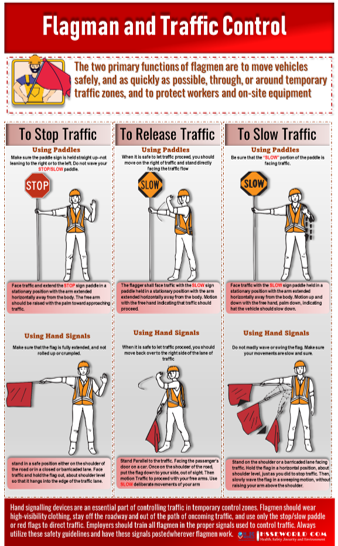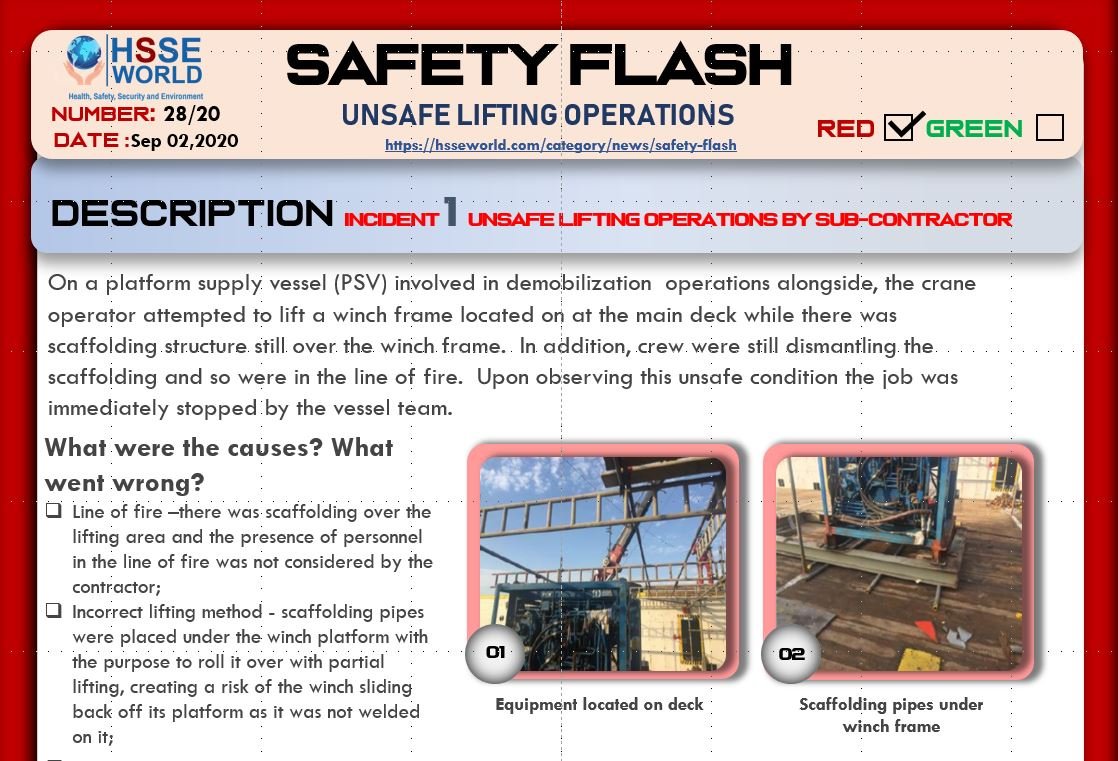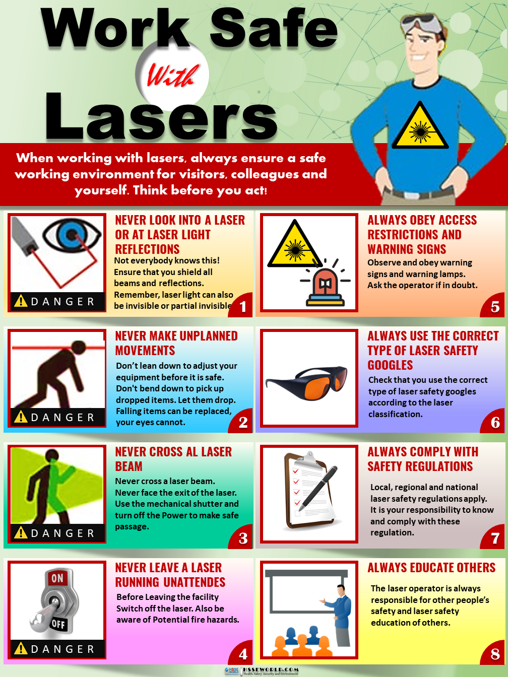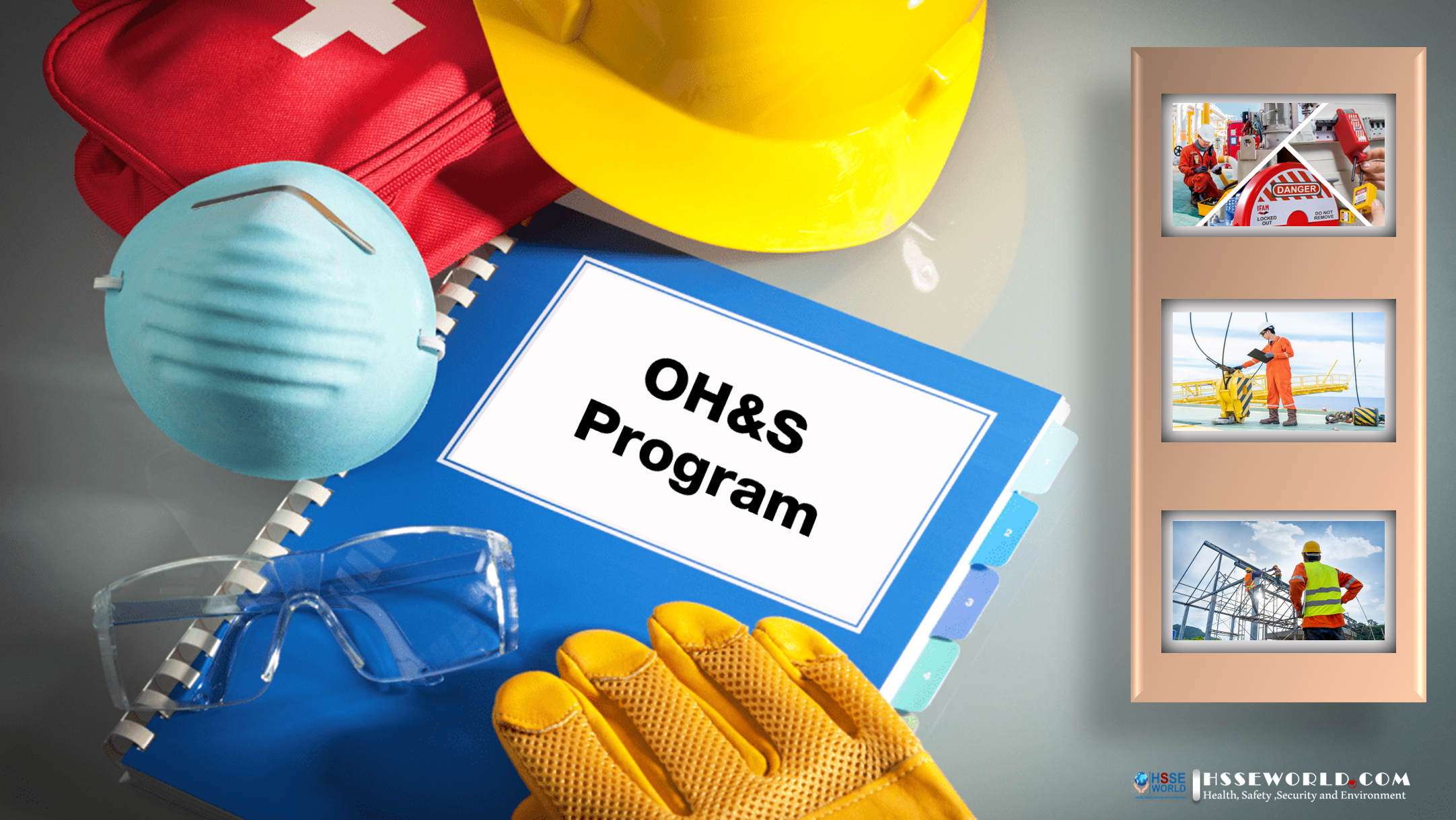Road construction is a necessary process of development for the comfort and safety of users. Most road construction is a tidies job whereby the duration and safety are always considered very important for the construction management. One of the most crucial factors in a road construction site is the safety of the road users and the construction workers. Proper safety signs and indications systems should be utilized to ensure safety to be optimized. The most common practice of safety indication is performed by a traffic controller or also known as the flagman.
The Photo of the day outlines the roles and responsibilities of flagmen and their big roles to control the traffic which is very crucial in a road construction site in ensuring the smoothness of the road traffic operation and to alert the road users on road construction activity, in addition, the basic flagging functions that flagman will be performing
Keywords: Flagman, traffic controller, road construction site, safety at road construction, intelligent traffic light.
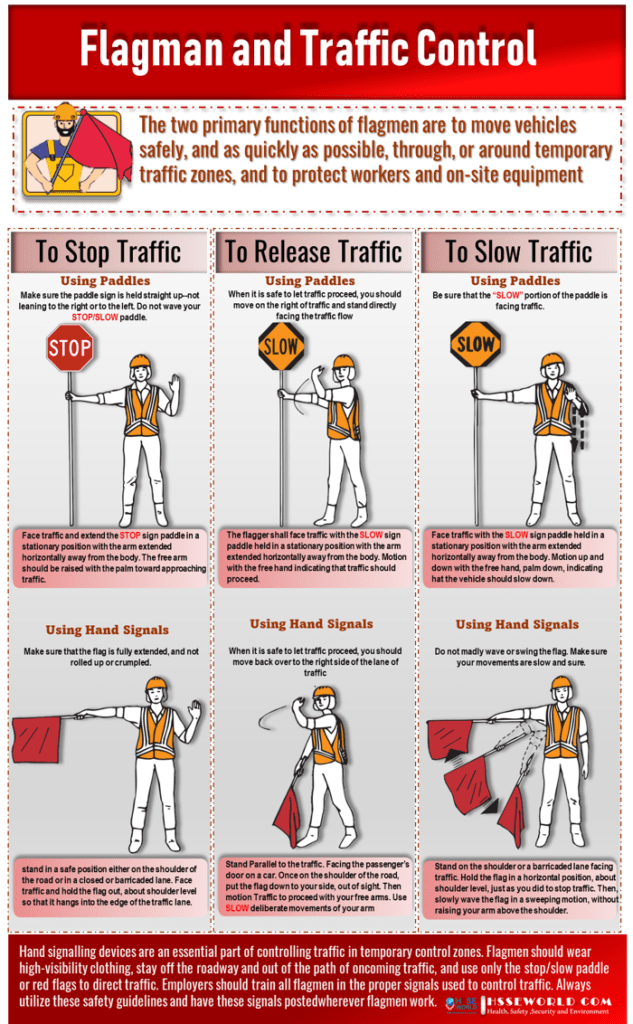
When FlagmenAre Needed
There are flagmen needed on all sorts of road construction and maintenance jobs across the state of Colorado. In general, flagmen are needed whenever the safety of the construction crew or the motoring public is a question. Safety questions arise whenever a traffic lane is going to be blocked, whenever an area is congested and construction equipment is going to be moved in or out of this area, and for many other reasons. Thus, flagmen are used to keep traffic moving smoothly and safely and to protect the crew members.
As a flagman, you may be working for construction companies–contractors who have submitted bids for and been retained to perform various road construction and maintenance projects. In addition, flaggers are usually needed for some projects run by public utilities, such as the telephone company or the gas company. All of these various jobs will require
the same standards of professionalism from flagmen. And, usually, the requirements, duties, and responsibilities in working for these various organizations will be the same.
WORKING FOR A CITY OR COUNTY ROAD DEPARTMENT:
City/county construction crews will be set up very much like the public utilities. Regardless of whom you work for a contractor someone like Salvador Sanchez, a public utility, or the city or county, your basic responsibilities and qualifications as a flagger will remain the same. You have read earlier about these responsibilities but let’s look at them again, in more detail. ( read more about Construction Site Traffic Management Plan (CSTMP) Guidance )
FLAGMAN BASIC QUALIFICATIONS
It is the EMPLOYER’S RESPONSIBILITY to ensure that the flagger meets the minimum qualifications as outlined in the Manual on Uniform Traffic Control Devices (MUTCD).
FLAGMAN BASIC RESPONSIBILITIES
Flagman will be responsible for
- PROTECTING himself and his co-workers from traffic that is passing through or around a road construction or maintenance site
- PROTECTING the traveling public from construction dangers that are present on the construction site
- GUIDING traffic efficiently through or around a construction site
- USING his skills and intelligence in all flagging situations
- Flag use should be limited to emergency situations, and low-speed and/or low-volume locations, that can best be controlled by a single flagger.
- Flags used for signaling shall be a minimum of 24 inches square made of high grade red material, and securely fastened to a staff at least 3 feet long.
- The free edges should be weighted so that the flag will hang vertically, even in heavy winds. Night flags are required to be retroreflective red.
- Flagger stations must be located far enough ahead of the work space, so that approaching traffic has sufficient time to stop before entering the work
- zone. This distance should be related to variables like approach speed, friction factors, pavement type, and road conditions.
- The flagman should stand either on the shoulder adjacent to the traffic being controlled, or in the barricaded lane. At a “spot” construction site, aposition may have to be taken on the shoulder opposite the barricaded section to operate effectively.
- A flagman should NEVER stand in the path of oncoming traffic to give direction, but may move into the lane after the traffic has stopped, if the
- flagman needs to communicate with the driver, or must be visible to other traffic.( Safe work site Activity for Traffic Management )
HOW TO FLAG
There are three basic flagging functions that flagger will be performing. he will be:
- Stopping traffic.
- Releasing traffic which has been stopped.
- Slowing traffic.
- Each of these functions will be performed differently. And there are different procedures forday and night time flagging. Let’s look a how flagman will do each of these functions.
1- DAYTIME FLAGGING
TO STOP TRAFFIC
Hold Paddles Straight-Flagman shall make sure the paddle sign is held straight up not leaning to the right or to the left. Do not wave his STOP/SLOW paddle. Make sure that the front of the “STOP” side is directly facing traffic. This way, the sign will be visible to motorists. When traffic approaches hold out his free hand/arm, above shoulder level, with his palm facing traffic.
Maintain Eye contact –This is a standard “STOP” hand signal. IT IS VERY IMPORTANT that his attempt to catch the driver’s eye. It will help him become more aware of what he is doing. Keep his position, and maintain eye contact until the driver comes to a complete stop. Be firm! and Make sure that the driver sees him.
Move to center-After the first vehicle has stopped, move to a clearly visible position near the center of the roadway or the left of the traveled lane. Be sure that he doesn’t move directly into traffic that may be coming the other way. Do not stand directly in front of the car you have just stopped. Remain in his “STOP” position until it is time to release your traffic to travel through the area.
TO RELEASE TRAFFIC
Show Slow Sign- When it is safe to let traffic proceed, the flagger should move to the right of traffic and stand directly facing the traffic flow. Only then turn the “STOP/SLOW” paddle to “SLOW”. Using slow arm movements, motion for the traffic to proceed.
TO SLOW TRAFFIC
Hand signals- The flagman shall Face the traffic and hold the paddle upright just as he would stop traffic. Be sure that the “SLOW” portion of the paddle is facing traffic. If he needs to emphasize his position, he shall raise and lower his free arm slowly in front of him, with his palm parallel to the ground. Be sure to make eye contact with each driver. If he is only trying to warn or alert traffic to the construction ahead, but he does not need to slow the speed of the cars greatly, stand in his position on the side of the road, or in a barricaded lane facing traffic and display the “SLOW” side of his paddle
2- NIGHTTIME FLAGGING
Reflectorized Equipment- Night-time flagging is a whole different ball game. Remember, everything that flagman use, vests, hard hats, paddles, or signs must be reflectorized. In addition, his flagging stand shall also be lighted. Thus, before the flagman steps out to perform his duties at night, shall make a quick check to be sure all of his equipment and required clothing is either reflectorized or has retroreflective tape on it. Also, be certain that his reflectorized material can still be seen if it becomes wet. In addition, it is a good idea to wear light-colored clothes under your vest at night. This will help him to be seen easily.
TO STOP TRAFFIC:
Hold Flashlight Out-The Flagman shall be sure that his flag station is lighted. Then, stand on the shoulder of the road or barricaded area facing traffic. Hold the paddle sign as he has learned for daytime flagging. he may hold his free arm out, palm facing traffic to emphasize his motion.
If he is using a flashlight or wand, hold it in his free hand, with his arm in a horizontal position. his arm should be about shoulder high. (Be sure that if he has a flashlight, that the proper 6-inch red cone has been attached.) Slowly swing the flashlight or other lighted materials in a sweeping motion across his body. Do not swing the flashlight
over your head. Keep your movements slow and deliberate and never swing the flashlight or wand above his shoulder.
TO RELEASE TRAFFIC
Lower the Flashlight-The signal that Flagman uses to get traffic moving should be made by lowering his flashlight to his side, standing facing traffic, and motioning drivers ahead with a slow, sweeping motion of his flashlight or wand.
TO SLOW TRAFFIC
The flagman shall Stand in with his lighted flag station, either on the shoulder of the road or in a clearly barricaded or marked area. Using the “SLOW” side of the paddle sign, he will slow traffic. Using a flashlight or wand, face the traffic, and slowly swing the light across his body, making sure that his arm does not swing above his shoulder.
Now you can download the Infographic of Flagman and Traffic control which can be used and posted at your workplace
Download the infographic
Flagman and Traffic control
More Photos
- What are the Best Practices for Managing Subcontractor Risk
- Photo of the day: 10 Essential Safety Tips for Driving in Hot Weather Conditions
- Photo of the day: best workplace safety tips
- Photo of the day: The Importance of Stop Work Authority in Maintaining Workplace Safety
- Photo of the day: Tomorrow’s Reward for Working Safely Today: Cultivating a Culture of Safety
- Photo of the day: Preventing slips and trips at work
- Photo of the day: Learn the DRSABCD action Plan
- Working with Electricity Electrical Accidents Guide for Electrical Workers
- Photo of the day: Hearing Protection Device Selection
- Photo of the day: If An Earthquake Shakes You-Infographic free
- Fire Safety Posters Free Download
- Photo of the day: First Aid for Electrical Burns-Infographic free
- Infographic: First Aid for Cuts and Scrapes free download
- Photo of The day: Work Safe with Lasers-Laser Safety free
- Photo of the day: Working Safely with chemicals and chemical Management
- Photo of the day: Safe work practices when using MEWPs ( updated)
- Photo of the day: Preventing Common Kitchen Hazards
- Photo of the day: Safe handling of Gas Cylinders and lecture bottles
- Photo of the day: Forklift Stability Triangle
- Photo of the day: Defective Tools Safe Work Practice
- Photo of the day: Lift With Your Legs Not With Your Back
- Photo of the day: First Aid for burns
- Photo of the day: The 7 Principles of HACCP
- Photo of the day: Working Safely with Suspended Loads
- Photo of the day: Heat Stroke First Aid and safety posters
- Photo of the day: Near-Miss Reporting and Posters
- Photo of the day: Ergonomic chair and office chair safety tips
- Photo of the day: Whole Body Vibration
- Photo of the day: Substation Safety Equipment
- Photo of the day: Bypassing Safety Controls Rules
- Photo of the day: Lightning Safety Tips
- Photo of the day: Overhead Power lines Clearance
- Photo of the day: Floor Marking
- Photo of the day: Types of Foot Protection
- Photo of the day: Types of Hand Protection
- Photo of the day: Lockout and Tagout Safety
- Photo of the day: Fall Protection Plans
- Photo of the day: Flood Safety Tips
- Photo of the day: Read All Labels Work safe
- Photo of the day: Run Project safely with Crane Hand Signals
- Photo of the day: Flagman and Traffic control
- Photo of the day: Managing Risks of Exposure to Solvents in the workplace
- Photo of the day: Scissor Lift Safety
- Photo of the day: HSE Bulletin Board
- Photo of the day: Arc-Fault Circuit Interrupters (AFCI)
- Photo of the day: Safe use of ladders and step ladders
- Photo of the day: Concrete Truck Driver Hand Signals
- Photo of the day: Extension Cord Safety Tips
- Photo of the day: Protect your Head
- Photo of the day: choosing the right Anchorage
- Photo of the day: Work-Related Asthma
- Photo of the day: Top FIVE Heavy Equipment Construction Site Safety Tips
- Photo of the day: sun safety in the workplace
- Photo of the day: Cannabis and Impairment in the Workplace
- Photo of the day: Position for safety and comfort-Safety Tips
- Photo of the day: Generator Safety
- Photo of the day: Controlling COVID-19 in the Workplace-Physical Barriers
- Photo of the day: Manual Material handling
- Photo of the day: Personal Protective Equipment last resort
- Photo of the day: WHMIS 2015 – Pictograms
- Photo of the day: Indoor Air Quality
- Photo of the day: Noise in the affected workplace
- Photo of the day: Fatigue at Work
- Photo of the day: Don’t be Driven to Distraction
- Photo of the day: working in heat and Humidex Rating
- How to use Plate Clamps Safely: Safety Moment#34
- Photo of the day: Sitting at work
- Photo of the day: 5 ways to reduce the risk of Slipping and Tripping
- Photo of the day: Preventing the spread of contagious illness
- Photo of the day: Incident Investigations
- Photo of the day: 10 Scaffold Safety Essentials
- Photo of the day: Effective Health and Safety Committees
- Photo of the day: New worker Orientation & Safety Orientation checklist
- Photo of the day: Workplace Inspection
- Photo of the day: musculoskeletal disorders
- Photo of the day: Emergency preparedness in the workplace
- Photo of the day: Mental health in the workplace
- Photo of the day: Trenching Safety Tips That Can Save a Life

